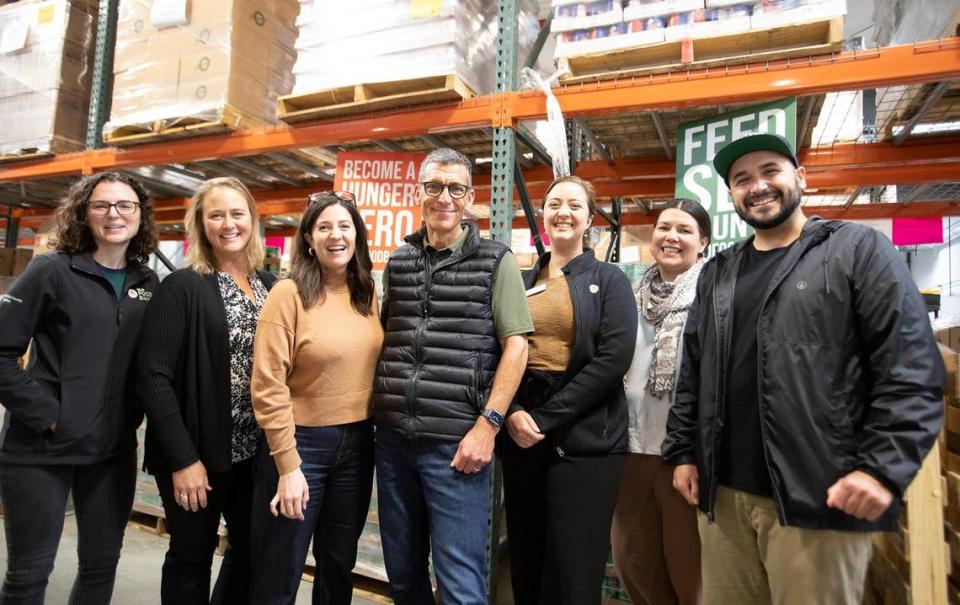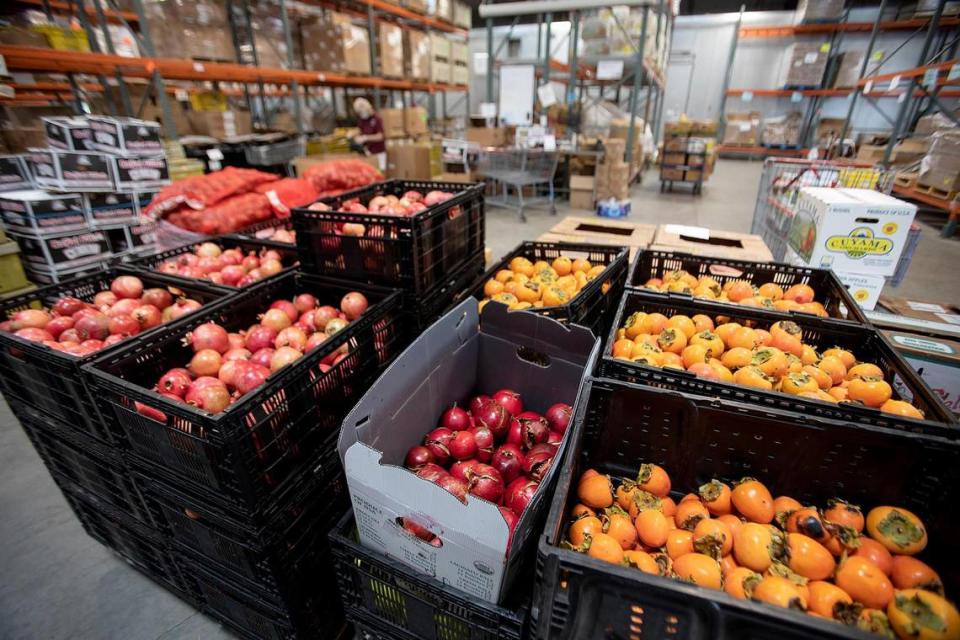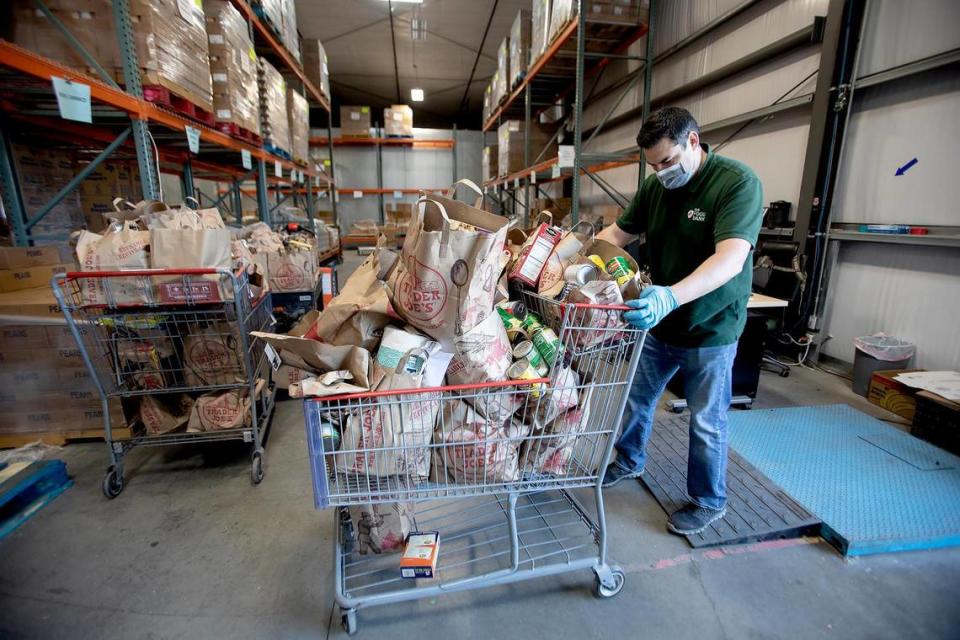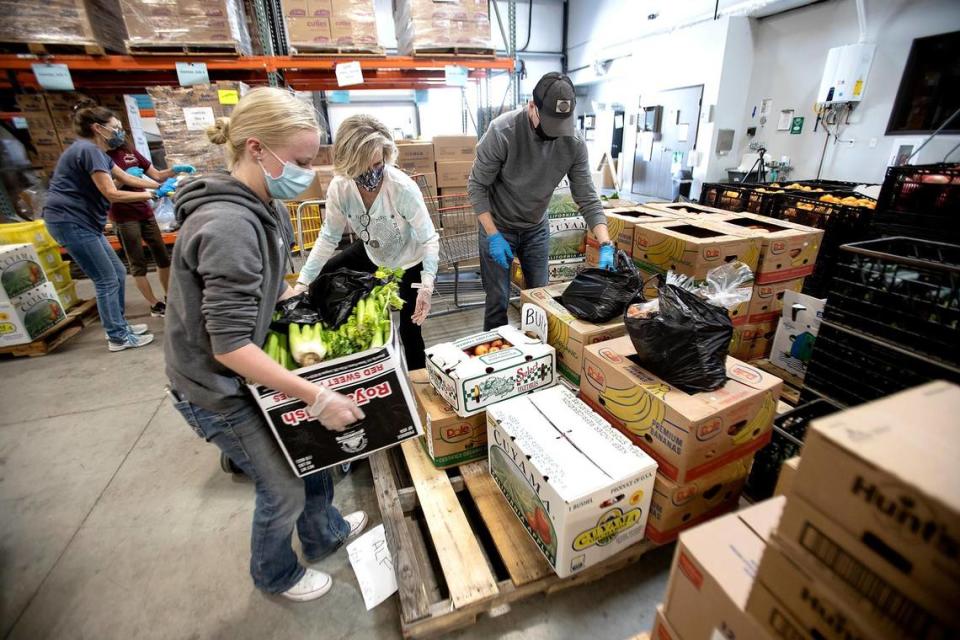SLO Food Bank is about to see a surge in demand. Here’s why — and how nonprofit is preparing
San Luis Obispo County’s food bank has weathered the COVID-19 pandemic, inflation and cuts in state benefits.
Now SLO Food Bank is about to face a fresh challenge: changes to the state’s CalFresh program that will cost an estimated 5.3 million Californians access to subsidized groceries.
According to SLO Food Bank CEO Garret Olson, “waves” of demand have pushed food banks across California to their limits.
However, the SLO Food Bank has not experienced the same lapses in supply as other nonprofit organizations due to good long-term planning, he said.
“We are reacting to a tragedy in our community, but we are focused on where we’re going to be — not just today or tomorrow, but a thousand tomorrows ahead of us,” Olson said.

SLO Food Bank predicts large ‘wave’ of demand
More than 80 nonprofit organizations rely on the SLO Food Bank for nutritional aid, and more than 200 homebound seniors receive food delivered to their homes through Senior Home Delivery every week, Olson said.
The SLO Food Bank distributes food directly to people in need through more than 40 neighborhood food distribution sites each month, he said.
Each month, the food bank serves 31,500 individuals across all of its community partnerships, Olson said.
According to Olson, SLO County saw a “historic increase” in demand for food aid at the start of the coronavirus pandemic.
“Prior to the pandemic, about 40% of all Americans had less than one month’s worth of savings in their savings account,” Olson said. “For most Americans, it only takes a month of being unemployed before all the sudden you start making difficult decisions.”
2020 was the high-water mark for the SLO Food Bank’s output, as distributions of food skyrocketed from around 3 million pounds of food each year to more than 5.1 million pounds, Olson said.
The food bank got some respite in 2021, when pandemic-related lockdowns began to ease, but later that year, inflation made food harder to come by, he said.

Low-income consumers were first to feel the stress of increased food prices, which started a second wave of demand at the SLO Food Bank, Olson said.
The next wave affected clients of CalFresh — California’s program for distributing federal Supplemental Nutrition Assistance Program food vouchers — more than anyone else, Olson said.
During the first two surges in demand, CalFresh’s emergency pandemic allotments added a minimum of $95 to every voucher. With these emergency allotments, a voucher for a household of one was worth around a maximum of $281, Olson said.
However, the expiration of those expanded benefits at the end of March meant the minimum value of a CalFresh voucher for a household of one dropped to just $23, Olson said.
That kicked off a third wave of demand for food assistance from SLO Food Bank, Olson said.
“It’s unimaginable what that does,” Olson said, referring to the CalFresh cuts. “We knew from other states that had seen their benefits evaporate in prior months just how much that was going to impact need in our community.”

Now, a fourth wave of demand is on the horizon, Olson said.
As a result of the Fiscal Responsibility Act of 2023, signed into law by President Joe Biden on June 3, eligibility changes in SNAP guidelines at the federal level may further reduce CalFresh’s ability to fulfill its clients’ needs, Olson said.
New work requirements for people between the ages of 50 and 54 would shrink the number of people who can receive CalFresh benefits, further increasing the load on food banks, Olson said.
“CalFresh is designed to provide nine out of 10 meals to somebody who is experiencing food insecurity,” Olson said. “The nonprofit sector, food banks and our partners are here to provide the bridge of that 10th meal.”
When eligible food-insecure people don’t take advantage of CalFresh benefits, that means the SLO Food Bank has to step up and provide all 10 of those meals, increasing operating costs “tremendously,” Olson said.
Olson said unused CalFresh benefits account for between $30 million and $50 million in lost economic impact in San Luis Obispo County each year.
Though the SLO Food Bank is not a distributor or administrator of CalFresh benefits, SLO Food Bank community programs director Andrea Keisler said her team has increased outreach efforts to vulnerable populations to connect them to benefits, which reduces the load on the food bank.
Keisler said between March and April, the SLO Food Bank has already seen a 7% spike in the number of individuals accessing the organization’s services.

How does food bank deal with surges in demand?
So how has the SLO Food Bank been able to meet surges in demand for food assistance?
Finding solutions to these problems requires planning ahead, according to Olson
“Why we are able to be as effective and efficient in what we do is because we are not a reactive organization,” he said. “We are a very forward-focused, strategic-minded organization.”
When the federal government began releasing funds at the start of the pandemic, “We looked long and hard at all those opportunities to take federal money and do things with it,” Olson said.
For example, he said, the SLO Food Bank used grant funding to prepay six years of lease expenses on a fleet of large delivery trucks, and sought a non-profit partner to provide cost-effective delivery of meals to home-bound seniors.
The strategy enabled the food bank to meet current needs, while setting them up for success years into the future, Olson said.
When CalFresh emergency allotments expired in March, the SLO Food Bank had already planned ahead and was able to meet the increased need, Keisler said.
As eligibility changes to the SNAP guidelines threaten the food bank with a fourth surge in demand, the team is already making preparations.
“Our staff has been out in the field talking to folks who are coming to the distribution sites,” Keisler said.
Doing so helps the food bank learn about upcoming threats to food assistance programs months before they actually happen, Keisler said.

Cliff Mendez, SLO Food Bank direct services manager, says this is part of a larger strategy to pay attention to what’s going on in the economy, food and food assistance programs such as CalFresh to see what changes are on the horizon.
“We try to anticipate that need by increasing our sites ahead of time by about 15 to 20%,” Mendez said.
Olson believes that the SLO Food Bank’s ability to meet rising demand is thanks to the efforts made by team members as well the local community and volunteers.
“We’ve never run out of food, we’ve never rationed food and we’ve never deviated from our nutritional standards,” Olson said. “We know that there are other food banks across the nation that have not had that same experience.”
How to get help
If you or someone you know is in need of food assistance, call 805-238-4664 or visit slofoodbank.org

